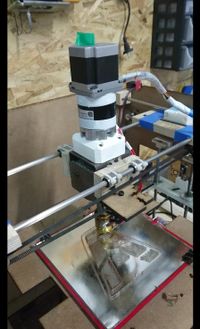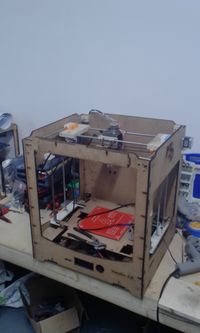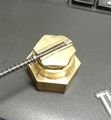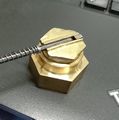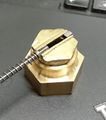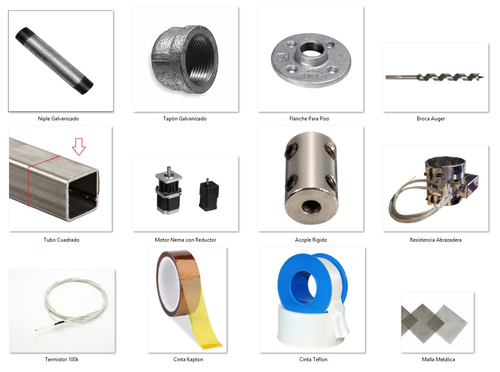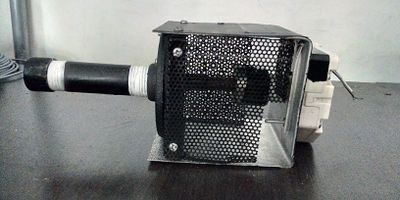Difference between revisions of "Pellet Extruder for 3D Printing"
(→Problem #2: Speed vs Productivity) |
(→Problem #3: Material Versatility) |
||
| Line 43: | Line 43: | ||
After some time of using 3D printers the regular user gets certain experience in the usage of the machines, their materials and ll the possiblities to obtain high quality pieces at the highest speed posible, sometimes not even taking care of the price of the tools or materials, the regular DIY 3D printer works with a printing head (extruder) which depose a thin hot filament on a building platform and draws the model layer by layer, with the mindset of quality the usage of small nozzles and deposing small volumes will always get a good result, but when the project becomes bigger and massive quantities of plastic have to be transformed, at this point the amount of spools of filament, the time that it could take to finish, and the delicate process of changing the filaments one spool after another. | After some time of using 3D printers the regular user gets certain experience in the usage of the machines, their materials and ll the possiblities to obtain high quality pieces at the highest speed posible, sometimes not even taking care of the price of the tools or materials, the regular DIY 3D printer works with a printing head (extruder) which depose a thin hot filament on a building platform and draws the model layer by layer, with the mindset of quality the usage of small nozzles and deposing small volumes will always get a good result, but when the project becomes bigger and massive quantities of plastic have to be transformed, at this point the amount of spools of filament, the time that it could take to finish, and the delicate process of changing the filaments one spool after another. | ||
| − | + | == Problem #3: Material Versatility == | |
After this lapse of time the user that uses 3D printing to produce prototypes for engineering, toys or even prosthetic hands, it's easy to find around the work place empty spools of plastic with the hope of be rewinded, a box full of at least 5 kilo of failed prints saved as a treasure waiting the moment to be melted and reused, not to talk about a rainbow collection of plastic spools ready to create fantastic creations, every person who works with a 3D printer will always want to have unlimited posibilities of mixing colors and materials, maybe the necessity of generate complex models of materials with special properties to improve mechanical efficiency or high temp performance. | After this lapse of time the user that uses 3D printing to produce prototypes for engineering, toys or even prosthetic hands, it's easy to find around the work place empty spools of plastic with the hope of be rewinded, a box full of at least 5 kilo of failed prints saved as a treasure waiting the moment to be melted and reused, not to talk about a rainbow collection of plastic spools ready to create fantastic creations, every person who works with a 3D printer will always want to have unlimited posibilities of mixing colors and materials, maybe the necessity of generate complex models of materials with special properties to improve mechanical efficiency or high temp performance. | ||
Revision as of 23:11, 18 November 2019
Contents
- 1 Project Developers
- 2 Introduction
- 3 Problem #1: Printing Volume vs Cost
- 4 Problem #2: Speed vs Productivity
- 5 Problem #3: Material Versatility
- 5.1 Extruder Design
- 5.2 Extruder Mechanics
- 5.3 Extruder Electronics
- 5.4 Assembly Manual
- 5.5 Building the Mechanics
- 5.6 Installing the electrical system
- 5.7 Mechanical efficiency test
- 5.8 Thermal efficiency test
- 5.9 Material flow test
- 5.10 3D Printer integration
- 5.11 Calibration and Testing
- 5.12 Reports & TS
Project Developers
| Maker | Photo | Profile |
|---|---|---|
| Bustos Fabian (Project Manager) |  |
|
| Duran Miguel (Assembly Assistant) |  |
|
| Sebastian Martinez (Assembly and Translation Assistant ) |  |
Introduction
After some years the FDM 3D printing patents and digital fabrication methods were released, the community started to discuss the fact that this industry is getting stuck, that FDM 3D printing is just a hobbie and a method for rapid protyping but not for serious applications in the serial production of products, due to this comments and bad publicity the members and developers of this project found a new way to change this reality, at this point the majority of 3d printing machines have three major problems to analyze and solve.
The first problem is about printing volume, when thinking about printing large objects the major limit is the cost of the material, if a printing session of a large object uses more than 2 rolls of filament the printing method can be discarded due to the cost and replaced by another techniques, this means that the 3D printing community fell into the consumption culture of inkjet printers for example, where the "brands" make more money by selling expensive cartridges of ink and tonners than by selling the actual paper printers.
The second problem is about printing time, due to the large list of coordinate movements that the machine executes to finish one model, the sum of this small portions of material deposed and time makes this FDM technology unsuitable for serial production or could even be seen as non-rapid prototyping method in some cases, analyzing the posibilities for upgrading a printing head to use a diferent technique of deposition, the solution points to increase the amount of plastic deposed versus time.
The third but not final problem depicted here, is the linearity of the materials, it means that if you have only one roll of white PLA plastic, you can only print white PLA models, if you want to make pieces of another color or if you want to make a model of multiple colors, you have to buy the same amount of rolls of plastic, its a good business model for the companies that release this technology for free to the people, but at the same time there is a huge economic interest which works effectively.
FM3D Pellet Extruder (In Spanish)
Problem #1: Printing Volume vs Cost
Looking around the social media, we can see that the majority of 3D printing machines are capable to print inside a volume less than 30 x 30 x 30 cm, it's due to the fact that those small volumes are enough to cover the average consumer necessities, because the system is made in that way, but if a new series of big 3d printers become popular and the materials cheaper?, the users would switch automatically to print big scale projects and the consommation of plastic increases. Curiously if you want to make a model that occupies all the volume of your 3D printer, you have to pay a price of plastic even major to the cost of the machine, it's a sad reality if we think about all the plastic we put into the trash every week.
Problem #2: Speed vs Productivity
After some time of using 3D printers the regular user gets certain experience in the usage of the machines, their materials and ll the possiblities to obtain high quality pieces at the highest speed posible, sometimes not even taking care of the price of the tools or materials, the regular DIY 3D printer works with a printing head (extruder) which depose a thin hot filament on a building platform and draws the model layer by layer, with the mindset of quality the usage of small nozzles and deposing small volumes will always get a good result, but when the project becomes bigger and massive quantities of plastic have to be transformed, at this point the amount of spools of filament, the time that it could take to finish, and the delicate process of changing the filaments one spool after another.
Problem #3: Material Versatility
After this lapse of time the user that uses 3D printing to produce prototypes for engineering, toys or even prosthetic hands, it's easy to find around the work place empty spools of plastic with the hope of be rewinded, a box full of at least 5 kilo of failed prints saved as a treasure waiting the moment to be melted and reused, not to talk about a rainbow collection of plastic spools ready to create fantastic creations, every person who works with a 3D printer will always want to have unlimited posibilities of mixing colors and materials, maybe the necessity of generate complex models of materials with special properties to improve mechanical efficiency or high temp performance.
Extruder Design
To solve the problems cited before we propose the development of a Pellet Extruder Printing Head wich works with granulated plastic, the most valuable improvement over filament extruders is the low price per kilo of plastic, this plastic pellet can be found in 25 kilo packets whose costs are less than price of one roll of regular PLA, the industrial method to produce filament in china factories starts with this small balls of plastic, they put some additives and colorants to modify the properties and color of the final product, this generates some uncertainty about what are we melting on our machines, what kind of fumes they produce and the grade of biodegradability this materials really have, the use of a Pellet Extruder on a 3D printer gives total freedom of using your own colorants to match an specfic tone of color, you can add some well known additives to improve the properties of the final models and even make them stronger mixing some carbon fiber chips or steel powder inside, it's the idea of printing composite materials.
There are already very good Pellet Extruders on the market ready to be installed on any xyz cartesian machine, but there is some different on the extruder we have to create, it's a mechanism that shortens the printing time, the system works with a Variable Width Nozzle, instead of using one fixed diameter hole at the output sharp point, we designed a plane metallic cap with a slit of 1x10mm, inside this slit we can find a moving piece that regulates the material output, the initial strategy to make it work faster than Filament Extruders is about using the small opening to mke the perimeters of the model, at the time of printing the infill it opens at the desired width or depending on the software to increase the printing volume and generate layers faster. The operation principle is the same that an industrial type plastic sheet extruder, but simplified to be installed in a moving shafts system.
Extruder Mechanics
The action strategy of the printing Tip is that when it is making outer perimeters the nozzle closes to let out a 1x1mm filament, that's how we can make the outer layers with good level of detailing, in the moment of filling the piece it opens up to 10mm wide and performs the work at least 6 times faster than a conventional extruder and when it is executing the displacements it closes completely to avoid unwanted extrusions before reaching the work coordinates.
Extruder Electronics
Assembly Manual
Disclaimer
This is a Technical Tutorial for the construction of an Industrial Grade Device which means that only qualified and experienced personnel could execute and obtain the appropiate result without damage, if you dont feel in the capacity to perform the tasks I show in the following steps, dont worry, just find the appropiate place, the appropiate person and the appropiate tools to get it done, keep in mind that the most important thing is your integrity and security, this is not intended as a manual to harm yourself in the process, be careful with the instructions, try to make this work in a good mood and mind clear of alcohol or any other product that could affect your performance, I dont take any responsibility of the use of this information.
Bill of Materials
- 1 X Water pipe Nipple 1/2"(dia) x 3"(long) double thread, Iron or Copper
- 1 X Water pipe cap 1/2"(dia) round, Iron or Copper
- 1 X Floor Flange Fitting 1/2" thread, Iron or Copper
- 1 X Auger bit 1/2"(dia) X 5"
- 1 X Square structural tube 70mm x 70mm X 70mm (long), Iron
- 1 X Nema 23 Stepper Motor with 1:72 Gearbox
- 1 X Rigid Coupling 5mm to 12mm (for bit and motor shafts)
- 1 X Band Resistive Heater 12v 90Watts 28mm(dia) X 30mm(long)
- 1 X Thermistor EPCOS 100K
- 1 X Kapton Tape de 30mm width
- 1 X Teflon Tape
- 2 X Metal Mesh Square 10x10cm
Manual Tools:
- Slot and Philips Screwdrivers
- Pliers
- Pipe Wrench
- Slim-Jaw Adjustable Wrench
- Allen Key Set
- Thread Tap M6
Electric Tools:
- Multimeter
- Drill
-Drill Bits -1" Saw Cup for Metal
- Angle Grinder
Before we start there is something that we have to understand, is the fact that we are dealing with high density thermoplastics, those materials need high temperatures and lots of force to manipulate, it means that all the mechanics we are going to build here will be made out of metal, because of this, hard work with "heavy tools" are needed, the material I've succesfully used is iron due to their ideal heath transfer properties for this project, avoid of use alluminum, if it is a problem for you to find iron parts you can use bronze instead which has been proven to give good result.
1.1 Cut 70mm of structural square tube of 70mm by 70mm, you can use the angle grinder with metal cutting disc, this cube will serve as container and the chassis of the extruder.
1.2 Use the Drill with the 1"Saw Cup to make two holes perfectly aligned at the center of the cube.
1.3 Place and center the flange in one hole, mark down the points where the screws will be placed, Place the motor on the other hole, carefully center the axle on the hole and mark down the points where the screws will support the motor.
Building the Mechanics
Installing the electrical system
Install the heating element, the heat sensor and motor wiring, this is connected to the machine's controller board.
Mechanical efficiency test
From the computer, send commands to the controller board to verify the correct movement of the pellets inside of the extruder, verify the speed and strength requirements.
Thermal efficiency test
From the computer, send commands to the controller board to verify the heating element performance and define the optimal temperature to melt the plastic and make it flow through the tube.
Material flow test
Heat the extruder to the work temperature obtained before, and define the motor's speed to produce a continuos string of plastic as fast as possible, maintaining the diameter and the material properties. In this step the lenght and material's retraction time are calculated, to get total control of the extrusion during an impression.
3D Printer integration
A cubic 30x30x30cm Kondoro machine chasis has been modified to fit the extruder inside, the mechanical arrangement of the X and Y axis was made temporarily out of wood and plastic ties meanwhile the final adjustments got done and the final 3D design reached the final version, at the end we In order to make this extruder work on a cartesian XYZE system we had to adapt our electronics and modify the Firmware of the microcontroller to add two extra actuators to the extruder to control the output flow and the orientation of the nozzle.
24/06/2019
- We have built a second printer that we will use exclusively for the development of the sheet extruder, it has a print volume of 300x400x300 mm, it was built using recycled materials, a whiskey box for the extruder and motors extracted from a paper printer, we use beer cans and resistive material from an old toaster for the heating element of the extruder.
Calibration and Testing
10/06/2019
Since the first assembly of the extruder, we used a Nema 17 motor of 2,2kg/cm Torque and 1:50 gearbox, which presented printing failures and loss of steps due to overheating, which also affected printing speed, something visible in the quality of the printed pieces, to solve this problem the motor has been replaced with a Nema 23 with 9 kg/cm torque and 1:72 gearbox, after the software adjustments and some tests, the extruder presented a better speed and acceleration control, and an improved print quality.
Reports & TS
Noviembre:
| Jueves 11 de Noviembre | Descripción | Tiempo | TS |
|---|---|---|---|
| Sebastian Martinez | Correciones y ampliacion de la Wiki | 1 Hora | 3 TS |
Octubre:
| Jueves 24 de Octubre | Descripción | Tiempo | TS |
|---|---|---|---|
| Sebastian Martinez | Impresión de soportes de cabezal de extrusor | 4 Horas | 12 TS |
| Miercoles 23 de Octubre | Descripción | Tiempo | TS |
|---|---|---|---|
| Fabian Bustos | Impresión de soportes de cabezal de extrusor | 3 Horas | 9 TS |
Septiembre:
| jueves 26 de septiembre | Descripción | Tiempo | TS |
|---|---|---|---|
| Sebastián | Adecuación (cables) de los motores del eje Y | 2 Horas 40 minutos | 8 TS |
| martes 17 de septiembre | Descripción | Tiempo | TS |
|---|---|---|---|
| Sebastián | Limpieza y reconstrucción de la impresora 3D, incluyendo adecuaciones a la estructura. | 2 Horas 20 minutos | 7 TS |
| jueves 12 de septiembre | Descripción | Tiempo | TS |
|---|---|---|---|
| miguel duran | poner rodamientos de el eje x | 3 Horas | 9 TS |
| viernes 12 de septiembre | Descripción | Tiempo | TS |
|---|---|---|---|
| miguel duran | poner motores de el eje x | 3 Horas | 9 TS |
| viernes 6 de septiembre | Descripción | Tiempo | TS |
|---|---|---|---|
| miguel duran | poner varrillas | 3 Horas | 9 TS |
| miercoles 4 de septiembre | Descripción | Tiempo | TS |
|---|---|---|---|
| miguel duran | cortar varrillas | 2 Horas | 6 TS |
Agosto:
| Lunes 12 de Agosto | Descripción | Tiempo | TS |
|---|---|---|---|
| Sebastián | Limpieza y reconstrucción de la impresora 3D, incluyendo adecuaciones a la estructura | 2Horas 20min | 7 TS |
TODO: Continuar construyendo la impresora de pellets Commentarios: Se espera la compra de los materiales de la lista [1]
| Viernes 9 de Agosto | Descripción | Tiempo | TS |
|---|---|---|---|
| Sebastián | Cambio del motor y limpieza parcial de la impresora | 3 Horas 20 minutos | 10 TS |
| Miercoles 7 de Agosto | Descripción | Tiempo | TS |
|---|---|---|---|
| Sebastián | Desarme, limpiado, pintado y rearmado del extrusor | 3Horas 40min | 11 TS |
| Martes 6 de Agosto | Descripción | Tiempo | TS |
|---|---|---|---|
| Sebastián | Agregar Imagenes a la seccion de ensamble mecanico y cambio del Link en la introduccion | 2 Horas | 6 TS |
Julio:
| Miercoles 31 de Julio | Descripción | Tiempo | TS |
|---|---|---|---|
| Sebastián | Traduccion Wiki del proyecto y correcciones | 3 Horas | 9 TS |
| Jueves 25 de Julio | Descripción | Tiempo | TS |
|---|---|---|---|
| Sebastián | Traducción de textos a inglés | 3 Horas | 9 TS |
